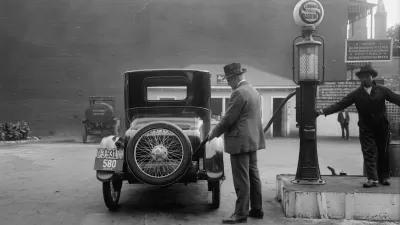Lucas Lindsey explores the rise and fall of gas stations in the U.S. With stations closing across the country, and cities wrestling with how to reclaim them, he looks at some that have found a new life through reuse, redevelopment, or repositioning.
The gas station has long been a mainstay of American urban form, but aggressive expansion during the U.S.’s post-war suburban boom effectively over positioned low-volume, small square footage stations throughout the country. Now the United States finds itself in the midst of a multi-decade decline in the number of gas station retailers. There’s a volatile mix of trends behind the steady evaporation of American gas stations—everything from market consolidation to tightening margins on retail sales. The forces at work are economically epic, structurally complex beasts beyond the remedy of any singular shift in market behavior or regulatory policy.
To a developer, a gas station’s highly specialized site layout and environmental risks make for an undesirable and needlessly complicated investment. As a result, many sit along the street boarded up and in disrepair. Forgotten, they are striking, even artistic, in what they symbolize: an old way of life in decline, but a decline that presents a possibility for change in values, purpose, and use.
Lindsey examines three strategies for finding new ways to use this specialized land use.
FULL STORY: Three Strategies for Refueling Abandoned Gas Stations

Planetizen Federal Action Tracker
A weekly monitor of how Trump’s orders and actions are impacting planners and planning in America.

Chicago’s Ghost Rails
Just beneath the surface of the modern city lie the remnants of its expansive early 20th-century streetcar system.

San Antonio and Austin are Fusing Into one Massive Megaregion
The region spanning the two central Texas cities is growing fast, posing challenges for local infrastructure and water supplies.

Since Zion's Shuttles Went Electric “The Smog is Gone”
Visitors to Zion National Park can enjoy the canyon via the nation’s first fully electric park shuttle system.

Trump Distributing DOT Safety Funds at 1/10 Rate of Biden
Funds for Safe Streets and other transportation safety and equity programs are being held up by administrative reviews and conflicts with the Trump administration’s priorities.

German Cities Subsidize Taxis for Women Amid Wave of Violence
Free or low-cost taxi rides can help women navigate cities more safely, but critics say the programs don't address the root causes of violence against women.
Urban Design for Planners 1: Software Tools
This six-course series explores essential urban design concepts using open source software and equips planners with the tools they need to participate fully in the urban design process.
Planning for Universal Design
Learn the tools for implementing Universal Design in planning regulations.
planning NEXT
Appalachian Highlands Housing Partners
Mpact (founded as Rail~Volution)
City of Camden Redevelopment Agency
City of Astoria
City of Portland
City of Laramie





























